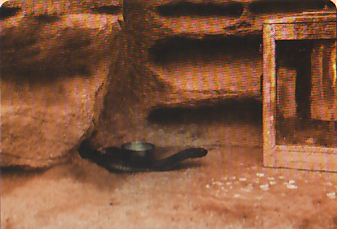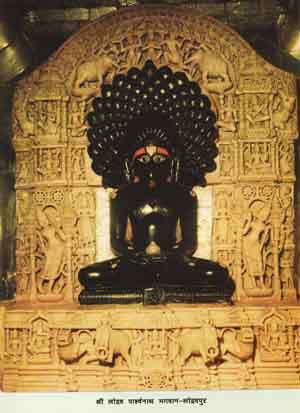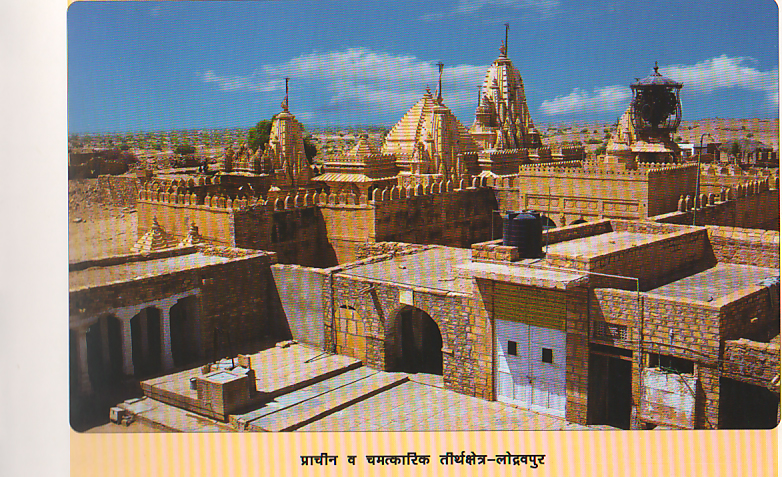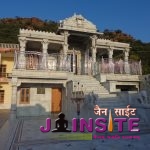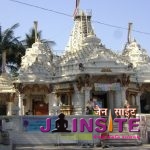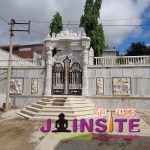SHRI LODARVAPUR TIRTH
PRESIDING DEITY AND LOCATION :
Shri Sahasfana (thousand hooded) Chintamani Parshvanath Bhagwan in black color, seated in a lotus posture , of height 100 Cms, located in a shrine in a devastated village named Lodarva, about 15 Kms from Jaisalmer and 5 Kms from Amarsagar (Shve).
ANTIQUITY AND SALIENT FEATURES :
It is said that in ancient times the town of Lodarva was a flourishing town among the capital cities of Rajputs. Ancient University of Bharat one time existed here and the place was world famous. Once upon a time king Sagar lived here. He had two sons, Shridhar and Rajdhar who had accepted Jainism as their religion after hearing discourses from Jain Acharyas. They had got built here a very large magnificent temple of Sri Chintamani Parshvanath Bhagwan, a reference to which fact is found in the laudatory composition entitled “Shatadal Padmayantra” written by learned Sri Sahakirtiganivarya, even at present on the right side of the inner sanctum of the temple. Thereafter the work of repairs and renovations of the temple was started by Sheth Sri Khismi and completed by his son Poonsi. In the course of time as a result of heavy destruction on account of war between Jaisalji and nephew Raval Bhojdev the city was completely brought to ruins and the temple too was damaged though in a little way.On obtaining victory uncle Jaisalji founded a new capital calling it Jaisalmer. Recognized by the state of Jaisalmer some affluent Jain householders had already built some temples in the fort within its walls and at that time the idol of Sri Chintamani Parshvanath Bhagwan which was reinstalled in a newly built temple there, which can be seen today.
The king among donors and very religious minded Sheth Sri Thirusha started later the repairs and renovations in this temple and when he returned from his Shatrunjay pilgrimage where he had gone accompanied by a large congregation of Jain householders, this work of repairs and renovations was completed. Then he was in search of a unique idol both majestic and divine for installation in the temple. As heavenly chance would have it, at that very moment two devout sculptors having sculpted two magnificent idols of thousand hooded Parshvanath Bhagwan out of a black kasoti stone ( a touchstone of testing gold) as their life time creations who were going to Multan stopped here overnight for rest. During the night they had a dream directing them to hand over the idols to Sheth Sri Thirusha who lived here. At the other end, Sheth Sri Thirusha also dreamt to take over these idols. Next day both the parties were on the look out for each other and when at last they did meet, the bargain was completed by Sheth Sri handing over to the sculptors an equal weight of gold in return, making them very happy and delighted. The wooden vehicle which can be seen today is the vehicle in which Sheth Sri Thirush had traveled to the shrines if Shatrunjay mountains for his pilgrimage and while returning had brought these idols in it. These idols were installed consecrated and sanctified here in ceremonies performed by Acharya on Magsar Sukla 12 in Vikram year 1673. It was thus that Sheth Sri Thirusha maintained the dignity and prestige of this ancient shrine once again for a long time in future by not only carrying out necessary repairs and renovations, but also by getting these magnificent idols installed with proper consecration and sanctification ceremonies.
This is the principal shrine of Jaisalmer Panch Tirth. The style of sculpture here is unique providing the fact that the old sculptures of Rajasthan by creating several specimen of special character at various places in Rajasthan have enhanced its prestige considerably in the field. Ancient “kalpavriksha” ( a tree which fulfills all wishes of the one who sits under it) can be seen here only. Once upon a time, this town was considered as one of the few important large towns in Bharat and that was the reason why it had the good fortune of once having Bharats largest university.
In olden times Jain Acharyas used to go to Multan enroute this city and area and that is why perhaps, the kings and princess who ruled here being impressed by their religious discourses, were accepting Jain religions as their own. These were the people who established such a great shrine here which, standing firm and stead fast in this desolate desert through thousands of years despite storms and hurricanes, reminds us today of the glory of Jain history. Indeed, all this is the result of the actions performed by Acharya and kings of merit due tot heir noble and purifying thoughts.
Thousands of ruins of old buildings scattered in the wild here, remind us of the old history. The pure and peaceful atmosphere prevailing in and near the shrine envelops the soul with a calm quietude never experienced before any where else. The Guardian God here appears ever present and works wonderful miracles. And this is the reason why during numberless invasions while surrounding area was destroyed, the shrine here was left untouched.
It is said that during recent Pakistani invasion, the Guardian God of this shrine assuming the form of Cobra appeared to the people several times sitting on the mast of the banner on the sikhar of this temple. No damage has been done to the temple during this invasion officers of the Bharatiya Army who passed through this area first paid their respect here by offering prayers of convenience, a compete tar road was made upto the doors of this temple by the Government during the invasion.
Only very recent an unprecedented but amazingly wonderful event has happened, the eye witness account of which is as follows :
Representatives of Shree Mahaveer Jain Kalyan Sangh from Chennai had gone there on the 1st of April 1975 during their all India tour to take photographs of various holy places. While they were returning after completing their ceremonial worship and prayers, they saw at the entrance gate a cobra. Believing this to be a form taken by the Guardian Deity they started photographing him but the cobra slipped away and hid himself below a stone under which there was neither a hole, nor a Cobra home. The workmen employed in repairs of the temple thereupon advised these devotees that as there was neither a hold nor cobra’s home at the spot, the cobra will be out again if the stone was removed thereby enabling them to continue taking its photographs. It was further rather laconically stated by them that a number of such cobras could be found in the wild area such as this one that this particular cobra however, could only be accepted as the one whose form was taken by the Guardian Deity if he appeared again in his own shrine which was constructed on a spot 30 meters away. The arguments thereupon started taking place. Some people anxious to have sight of this cobra were waiting intently seated near the stone but the cobra had already disappeared. Suddenly in a few moments, some one said that the Guardian Deity in the form of the Cobra had appeared near his own shrine and with great surprise, bewilderment and awe, the representatives, the sculptors and the temple priest ran in that direction. Overjoyed and delighted at the sight of fully hooded cobra quietly serene and dignified, they offered him devout prayers and he in turn allowed devoted photographer Gopalratnam to take photographs as per his wish. The scenario continued for 20 minutes. A movie also was taken. Sangh’s representatives were wearing clothes usually worn while performing ceremonial worship and prayers and in their hearts during these moments, a desire of such worship arose. As they had with them a bowl filled with saffron paste they even fulfilled this desire of theirs by sprinkling saffron at the cobra where after he disappeared again. , making this whole event of celestial implications memorable hereafter for Guardian Deity in this shrine appeared often to devote followers but on this day, this unprecedented event proved that the Guardian Deities in the whole of Jain order were ever present. It is therefore recommended that a pilgrimage, even one to this shrine by devout Jains should not be missed. The artful work over here is quiet different and is in a class of its own. One can fine intricately carved work on each and every stone of the Pillar, Ceiling and Sikhar. It is seen from the idols over here that the sculptures were really very enthusiastic and carved the idol with full of zeal to make it an impressive and charming one. The art work, on the “Toran” of Pravesh-Dvar is enthralling. Such an idol (done in “kasoti” stone) of one thousand hooded cobra making a protecting umbrella over the head of Sri Parshavanth Bhagwan is difficult to come across at any other place. Even the wooden cart on which the idols were brought here from Patan has its own artistic characteristics.
There are no other temples here. Opposite the temples there is a Dharamshala in which there is only a Dadawadi ( a small shrine wherein are enshrined foot-prints of an erudite scholar Acharya which often also serves as a place for temporary rest by Jain pilgrims.)
APPROACH – ROUTE :
The nearest railway station is Jaisalmer which is 15 Kms away where Jeeps and taxis are available. There is a tar road upto the temple. Private buses and cars can ply right upto the doors.
AMENITIES FOR JAIN PILGRIMS :
For lodging there is a dharamshala just opposite the temple with all facilities and bhojanshala for meals is available.
MANAGED BY :
Shri Jaisalmer Lodarvapur Parshavanth Jain Shvetamber Trust,
Village : Lodarvapur, Post : Jaisalmer – 345 001
Rajasthan
Tel : 02992-50165

